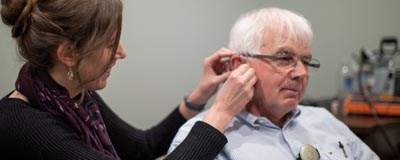Otosclerosis is a medical condition that affects the ossicular chain in the middle ear, leading to hearing loss. The ossicular chain is composed of three bones: the malleus, the incus and the stapes. These bones connect the ear drum to the cochlea in the inner ear. Otosclerosis is the irregular growth of bone in this area. This additional growth makes it difficult for the ossicles to naturally vibrate when sound waves hit the eardrum. Due to the lack of vibration, the ossicles cannot conduct sound as efficiently, thus resulting in a conductive hearing loss.
Otosclerosis most commonly affects the stapes, the third bone in the ossicular chain. The stapes is crucial for transmitting sounds to your cochlea. The extra bone growth can happen at the junction of the incus and the stapes or at the footplate of the stapes where it attaches to the round window. Individuals affected by otosclerosis may experience increased difficulty hearing low frequency sounds, such as bass instruments, or some speech sounds.
Otosclerosis can develop for three main reasons; genetic predisposition, viral infection such as measles and abnormal thyroid function or estrogen count. It can develop very slowly, or quite quickly. Due to the proximity of the stapes to the cochlea, the condition can progress into the cochlea in 10% of cases. Irregular bone growth in the cochlea can introduce sensorineural damage such as the loss of hair cells and nerve damage. The cochlea’s close connection with the vestibular system can also introduce balance and vertigo problems.
Detection and Treatments:
If your hearing health care professional detects the symptoms of otosclerosis during a complete hearing evaluation, they will recommend a referral to an Ear Specialist physician. If bone growth is continuous, often times medication such as sodium fluoride is used to slow down growth. In other cases, surgery is chosen to remove the irregular growth, or replace the stapes with a prosthetic. Hearing aids can also be used very successfully to drive extra sound through the ossicular chain and overcome the conductive hearing loss.
The best method of prevention is to test your hearing every few years, or sooner if hearing difficulties are noticed. A complete evaluation will ensure that all parts of your ear are working in harmony. Visit your nearest Davidson Hearing Aid Centres location to complete a hearing evaluation today!






